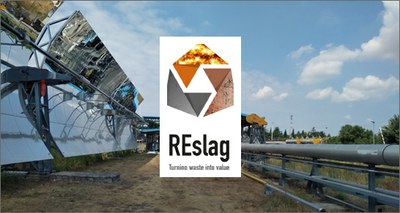Energy: New life for steel industry waste
5/12/2019
 Re-using steel industry waste to store thermal energy in thermodynamic solar plants – this is the new frontier for ENEA research in the field of circular economy, to direct the steel industry towards a “zero waste” approach, within the ambit of the European REslag[1] project. In Europe alone, around 20 million tons of steel slag are produced each year. Most of the slag (75%) is used in construction and roadworks.
Re-using steel industry waste to store thermal energy in thermodynamic solar plants – this is the new frontier for ENEA research in the field of circular economy, to direct the steel industry towards a “zero waste” approach, within the ambit of the European REslag[1] project. In Europe alone, around 20 million tons of steel slag are produced each year. Most of the slag (75%) is used in construction and roadworks.
The remaining 25% (over 5 million tons, the equivalent in weight of 650 Eiffel Towers) is either stored on-site at production plants or disposed of in landfills, with clear environmental impacts.
According to Luca Turchetti, a researcher at ENEA’s Divisione Solare Termico, Termodinamico e Smart Network (Thermal and Thermodynamic Solar and Smart Network Division), “For this project we replaced a part of the molten salts used by the concentrating solar power installation to accumulate high-temperature thermal energy (up to 550 ºC), with duly reprocessed blast furnace waste.”
There were many benefits: by using these materials we can reduce the costs of concentrating solar technology and obtain an even more sustainable electricity production system, recycling an industrial waste material otherwise destined for on-site storage or landfill.
“Thanks to this experimentation”, adds Turchetti, “we have devised a low-cost system for accumulation of thermal energy that may pave the way for diffusion of concentrating solar energy solutions, a ‘100% green’ technology capable of decoupling the production phase of thermal energy and conversion into electricity and, therefore, capable of producing electric current based on grid demands even in the absence of solar radiation.”
Walter Gaggioli, head of the Laboratorio Ingegneria delle Tecnologie Solari (Solar Technologies Engineering Laboratory) and ENEA’s REslag project coordinator concludes: “After successful implementation of this experimental infrastructure, our thermodynamic solar installation with the new system of thermal accumulation based on molten salts and slag was included among the facilities open to the European researchers of the SFERA III project regarding concentrating solar thermal energy.”
The energy sector is just one of the four areas of experimentation of the REslag project, which aims at “near-zero-waste” steel production.
The other areas regard heat recovery in the steel industry, the production of refractory ceramic materials and extraction of high added-value metals. In addition to re-use of slag destined for landfill or on-site storage, these efforts all translate into, in environmental terms, reductions of raw materials used (20%), of energy[2] consumed (up to 20%), and of CO2 (up to 70 kg less per ton of steel produced).
Once all the experimentation work has been completed, the next step is transferring this innovation to the industry, as attested to by the pilot prototype constructed and tested during this project by the CIC energiGUNE coordinator at ArcelorMittal Sestao (Spain). REslag − funded by the EU Horizon 2020 programme with about 9 million euros − has involved 19 partners from 8 countries (Spain, Germany, Switzerland, United Kingdom, France, Italy, Finland and Morocco): ENEA is joined by CIC energiGUNE (the coordinator), ArcelorMittal, DLR, IK4-Azterlan, ETH, Imperial College London, Friedrich-Alexander-Universität Erlangen-Nürnberg, CEA, Optimum Cement, VIT, General Electric France, Novargi, General La Svizzera elettrica, Fraunhofer IWKS, Ingegneria del ciclo di vita, MASEN, Hasten, Renotech and CENER.
For further information:
Luca Turchetti, ENEA - Divisione Solare Termico, Termodinamico e Smart Network (Thermal and Thermodynamic Solar and Smart Network Division), luca.turchetti@enea.it
Walter Gaggioli, ENEA – Head of the Laboratorio Ingegneria delle Tecnologie Solari (Solar Technologies Engineering Laboratory), walter.gaggioli@enea.it
[1] Turning waste from steel industry into valuable low cost feedstock for energy intensive industry
[2] Thanks to storage of thermal energy applied to the gas discharged by electric-arc furnaces
